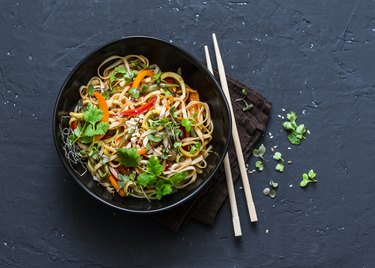
When looking at diets from around the globe, it's always interesting to see how the American diet compares to other cuisines, especially in Asia. While the countries and regions in the largest continent in the world may vary, many people are curious about a Japanese meal plan for weight loss.
Asian Diet Plan Guidelines
Video of the Day
To say that the traditional Asian diet covers a lot of territory, would be an understatement. With cuisines coming from countries like Japan, China, India, Thailand, Vietnam, South Korea, Mongolia, and many more, generalizing the dietary habits from this broad of a geographical base is challenging. That said, many of the Asian countries do have some common characteristics when it comes to their dietary practices.
Video of the Day
According to Harvard Chan T.H. School of Public Health and the National University of Singapore, the traditional Asian diet plan includes:
- Rich variety of fruits and vegetables
- Lots of beans, legumes and nuts
- Rice and noodles as staple foods
- Use of spices and herbs with food
- Fish and seafood for protein
- Low red meat consumption
- Whole grains like brown rice, millet, barley, soba (buckwheat) noodles, or whole wheat flatbreads
- Sweets and desserts consumed sparingly
Green tea is another staple in many Asian diets and for good reason. An October 2014 study published in the European Journal of Clinical Nutrition, found that drinking green tea can increase the amount of fat and calories you burn and help reduce appetite.
Japanese Meal Plan
According to the food-based dietary guidelines for Japan published by the Food and Agriculture Organization of the United Nations (FAO), Japan uses a food pyramid with dietary recommendations that places grain-based dishes such as rice, bread, noodles and pasta at the top, followed by vegetable-based dishes.
The next focus is on fish, eggs and meat dishes, followed by milk and fruit. The pyramid also says to drink plenty of water and tea and to limit highly processed snacks and beverages. Additionally, the Asian diet plan and Japanese meal plan for weight loss place a significant emphasis on controlling portions, which is key to a dieter's success.
While the FAO guidelines do not list a Japanese meal plan for weight loss, you can use their guiding principles to help develop a weight loss plan that works for you. Some of their beliefs that translate to healthier eating for losing weight include:
- Keeping regular hours for meals
- Focus on staple foods for well-balanced meals
- Eat plenty of grains
- Include a variety of vegetables, fruits, beans and fish in your diet
- Avoid excess salt and fat
- Balance the calories you eat with daily physical activity
Read more: The Ultimate Guide for Fat Loss
Tips for Healthy Weight Loss
Regardless of the diet or meal plan you choose to follow, there are some basic principles to consider when it comes to losing weight. The Academy of Nutrition and Dietetics advises anyone wanting to lose weight and keep it off to steer clear of any diet that claims rapid weight loss doesn't include exercise as part of the plan, requires you to follow a rigid menu or eliminates entire food groups.
Instead, make sure to choose from a wide variety of fruits, vegetables, lean protein, complex carbohydrates and healthy fats. As far as calories, the number you need to eat each day to maintain your weight depends on a variety of factors including your current weight, activity level and age.
In general, the Academy of Nutrition and Dietetics says women need between 1,600 to 2,400 per day, and men, 2,000 to 3,000 calories per day. The lower end represents a sedentary lifestyle, while the higher end is for people who are very active.
The Centers for Disease Control and Prevention says a safe weight loss of 1 to 2 pounds a week is recommended for most people. To meet this goal, you can reduce your daily calories by 500 if you want to lose 1 pound or by 1000 calories if you want to lose 2 pounds per week.
- Centers for Disease Control and Prevention: "Losing Weight"
- Harvard T.H. Chan School of Public Health/Asian Diabetes Prevention Initiative: "Asian Diets: Health Benefits and Risks"
- Food and Agricultural Organization of the United Nations: "Food-Based Dietary Guidelines-Japan"
- European Journal of Clinical Nutrition: "The Anti-Obesity Effects of Green Tea in Human Intervention and Basic Molecular Studies"
- Academy of Nutrition and Dietetics: "Staying Away from Fad Diets"
- Academy of Nutrition and Dietetics: "How Many Calories Do Adults Need?"